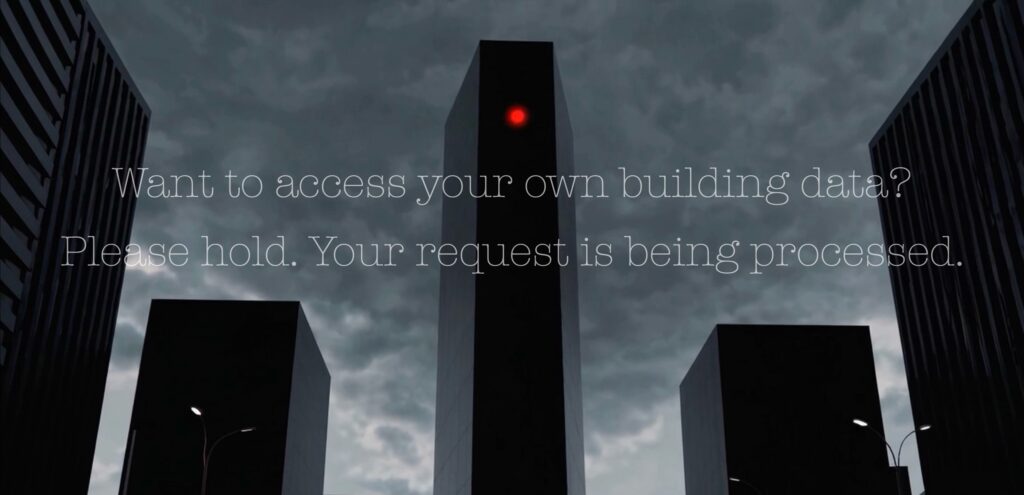The Building Industry’s AT&T Moment Has Arrived.
When AT&T was broken up in 1982, it ended a monopoly that had controlled phone service for decades. Suddenly, we had choices—long-distance costs dropped, competition thrived, and new technologies emerged. Building systems need to be broken up. Why are buildings still trapped in proprietary systems that block innovation, limit choice, and prevent owners from taking control?
In the late 1970s, calling between the U.S. and Japan cost $5 per minute (the equivalent of $28 today) — not because of technology limits but because a phone company monopoly controlled access.
As a high school senior, communicating with my overseas girlfriend required:
- Sending letters back and forth to schedule a day and time so as not to miss the call.
- Getting permission from my parents—it was their phone bill, and every second cost money.
- Coordinating with an operator wasn’t as easy as dialing a number.
- Sticking to a three-minute limit—because anything longer was super expensive.
The phone monopoly controlled the entire communication experience. They blocked competition, charged extra fees, and decided the cheapest time to connect — very similar to today’s building systems.
Question: Are you the owner or a tenant in their system?
Today, instant, inexpensive global communication is ubiquitous, and we are not trapped in black box phones.
Who really controls your building? You or the proprietary operator?
Like the phone monopolies used operators to grant permission to connect a call, today’s proprietary building systems do the same. Except now, the “operator” is controlling access to your data.
Every integration, every connection, and every attempt to use your building’s systems must go through them.
Buildings are not connected—they are trapped.

Technology has been ready, but the industry has not.
The problem isn’t technology—it’s control. The tools to connect buildings have existed for years, but the industry traps them inside proprietary systems.
Onuma connected cloud-native Building Information Models (BIM) to sensors, live energy data, and automation—16 years ago. It worked.
- Real-time sensor data streaming into cloud-based BIM models—years before the industry was ready.
- Connections explode to 71 Million Square Feet for the California Community College System
Instead of embracing open connections, the industry ignored opportunities, resisted change, and clung to closed systems by using:
- legacy systems that did not connect, with no incentive to change – keeping data locked meant keeping control.
- consultants that implement proprietary solutions — and sold lock-in systems because open systems threatened their business model.
- internal IT teams that used brittle, closed systems —fearing disruption locked things down even more
- past memories of integration failures
- biased input from vendors, consultants, and their own IT teams — leading them to believe that single-solutions are “simpler and safer”— which only traded control for dependency.
Owners became convinced that open connections were risky, too complex, and simply not possible.
The truth? It wasn’t about protecting owners — it was about protecting control.
A real digital twin is a system of systems — not a single system-controlled platform.
Owners who don’t push back will stay trapped for another decade.

If your building only works on their terms, do you control it?
Currently, many building systems operate like old phone monopolies. They trap owners inside proprietary ecosystems, blocking integrations, controlling access, and making it difficult or costly — to escape.
Think about booking a hotel reservation today.
Whether it’s Expedia, Booking.com, or the hotel’s website—the reservation goes through. iPhones or Androids can open a hotel door room and connect to the hotel Wi-Fi.
This does not happen with a single, all-powerful hotel app. It happens because the industry is using open connections.
Imagine if hotels ran proprietary building systems that only allowed:
- booking through a single travel agent, charging extra to modify a reservation.
- using proprietary room keys and charging $100 for lost keys – because only their keys work with their system.
- connecting to Wi-Fi on certain devices, so if you brought the “wrong” device, you could rent the “right” device from the hotel for a fee.
- paying with cash, with other forms of payment requiring a fee.
Absurd? Yes. But this is exactly how today’s proprietary building systems trap owners—one restriction at a time.
Instead of letting systems talk to each other, systems trap owners in their ecosystem, blocking integrations unless they control them. Vendors claim this is for security, but it’s really about control.
Buildings shouldn’t be like Hotel California, where the data checks in but can never leave.
Your building is a prison, not a smart asset
A building you don’t control isn’t an asset—it’s a liability. Owners should ask:
- Who actually controls my building’s data and systems?
- Are there limits to the number of systems that can connect?
- Does the system lock to a particular vendor?
- When the system stops working, can only the vendor fix it?
Stay trapped for years—or start the break-up today. Join us at AHR to take control.
Join the Interoperable Building Box:
- Smarter Summit 25 Feb. 9, 3 pm- 5 pm
- IBB Workshop – Feb. 12, 11 am-2 pm
- Booth #1190 at AHR – Coalition for Smarter Buildings, Interoperable Building Box



